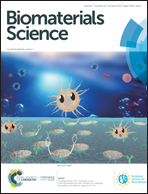Use of l-pNIPAM hydrogel as a 3D-scaffold for intestinal crypts and stem cell tissue engineering
Abstract
Intestinal stem cells hold great potential in tissue regeneration of the intestine, however, there are key limitations in their culture in vitro. We previously reported a novel synthetic non-biodegradable hydrogel as a 3D culture model for intestinal epithelium using Caco2 and HT29-MTX cells. Here, we investigated the potential of this system as a 3D scaffold for crypts and single intestinal stem cells to support long-term culture and differentiation. Intestinal crypts were extracted from murine small intestines and Lgr5+ stem cells isolated by magnetic activated cell sorting. Crypts and stem cells were suspended within Matrigel or L-pNIPAM for 14 days or suspended within Matrigel for 7 days then released, dissociated, and suspended within, or on L-pNIPAM hydrogel for 28 days. Cellular behaviour and phenotype were determined by histology and immunohistochemistry for stem cell and differentiation markers: Lgr5, E-cadherin MUC2 chromograninA and lysozymes. Isolated crypts and Lgr5+ intestinal stem cells formed enteroids with a central lumen surrounded by multiple crypt-like buds when cultured in Matrigel. In contrast, when crypts and stem cells were directly suspended within, or layered on L-pNIPAM hydrogel under dynamic culture conditions they formed spherical balls of cells, with no central lumen. When enteroids were initially formed in Matrigel from crypts or single Lgr5+ intestinal stem cells and dissociated into small fragments or single cells and transferred to L-pNIPAM hydrogel they formed new larger enteroids with numerous crypt-like buds. These crypt-like buds showed the presence of mucin-producing cells, which resembled goblet cells, scattered throughout their structures. Immunohistochemistry staining also showed the expression of Lgr5 and differentiation markers of all the main intestinal cell types including: enterocytes, goblet cells, enteroendocrine and Paneth cells. This demonstrated that L-pNIPAM hydrogel supported long-term culture of crypts and Lgr5+ stem cells and promoted intestinal cell differentiation.



 Please wait while we load your content...
Please wait while we load your content...